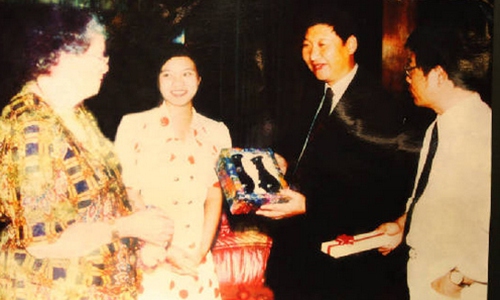ARTS / CULTURE & LEISURE
Kuliang spirit endures, carries the essence of young people’s friendship between China and the US
Inheriting the legacy

Kuliang, a scenic spot in Fuzhou, East China's Fujian Province Photo: VCG

Chinese young people take a photo with a student from the US in Fuzhou. Photo: Courtesy of FHNW
Snowflakes fell gently outside the window, as old man Donald MacInnis from the US leaned back on his rocking chair and closed his eyes peacefully. Before his passing, he held the letters from his second hometown - Fuzhou, East China's Fujian Province - in which his Chinese students sent him warm greetings.
Like "the falling leaves return to its roots," half of his ashes were scattered in the Minjiang River, Fuzhou's "mother river," as he requested in his will.
Donald MacInnis was a member of the Flying Tigers, a group of US volunteer fighter pilots who helped China fight against Japanese troops during the War of Resistance against Japanese Aggression (1931-45). He later taught in a university in Fuzhou for several years. MacInnis' strong affection for China deeply moved his son and daughter-in-law Elyn MacInnis who came to Kuliang, Fuzhou this summer and shared MacInnis' beautiful stories with the Chinese youth.
"I was moved to tears after Elyn told us the story of her father-in-law," Zhou Tianyi, a 23-year-old colleague student from East China University of Science and Technology (ECUST), told the Global Times.
Inherit the Kuliang spirit
Zhou and her fellow Ye Yuhan participated in an online project that helps re-build the connection between the foreign people who lived in Kuliang in the 1940s, under the guidance of their mentor Lin Yinan, a professor at the ECUST, and a Fuzhou local whose family shared close ties with foreign people based there in the past.
Lin told the Global Times that every time his students hear the stories of Kuliang, they are deeply moved.
The two students expressed their transformation from merely seeking internship experience to genuinely wanting to serve the Kuliang community and assist American senior citizens wishing to retrace their roots after learning about these touching stories.
With support from students from the School of Information Science and Engineering at the ECUST, the website could utilize AI facial recognition technology to match old photographs with individuals, allowing users to access information about their family trees and personal profiles.
Additionally, the houses where the Americans once resided in Kuliang have been noted, enabling those in search to find their childhood homes when they return to rediscover their roots.
In the future, they hope to transmit the spirit of Kuliang to more people using methods that resonate with the younger generation.
For instance, they aspire to recreate popular local dishes and jasmine milk tea enjoyed by Americans living in Kuliang in the past, as well as developing more cultural and creative products. By embracing these interesting approaches, visitors can better understand the stories of Kuliang.
Elyn MacInnis told the Global Times that connections to members of the Kuliang community have been better built thanks to the help of the young people, and they are using their talents to inherit the Kuliang spirit of "peace, friendship, and love with understanding and respect" in a more innovative and modern way.
She looks forward to launching more people-to-people exchanges among the young generation between China and the US.
The Kuliang spirit has not only been kept alive in Kuliang but also in Fujian Hwa Nan Women's College (FHNW), the first president of which was American Lydia Trimble. In the early 20th century, driven by the firm belief that women have the right to education, she established the women's college in Fuzhou, promoting the development of female education in China.
Ren Jianhong, the current president of FHNW, told the Global Times that until now, the spirit of Kuliang has been perpetuated through cultural and educational exchanges with US schools.
With the support of the Trimble Foundation, students from two US schools have come to FHNW for study tours. One group from Sacred Hearts Academy in Honolulu, Hawaii, consisted of 10 students (aged approximately 14-17) and 2-3 teachers.
The other group was from the University of Puget Sound in Tacoma, Washington, comprising around 30 students (aged 20-21).
Kira Stone, a student representative, expressed her joy at getting to know and understand the profound history of Fujian Province and China through this unique experience.
Wu Linjing, a Business English major student at FHNW, also shared her experience while on a short study tour at the Sacred Hearts Academy.
She told the Global Times that the American students she met showed strong interest and curiosity about China after listening to her introduction of the history and representative landmarks in Fuzhou.
A shared memory
Taking a stroll along the old streets of Kuliang, one can appreciate the lush trees and a sense of the passage of time.
Nestled among the mountains, the Life On The Mountain Museum, also known as the Cross-Cultural Education Center, quietly recounts the heartwarming stories of China-US folk friendship by displaying old items donated by the Kuliang community.
Here, many young people ascend the mountain paths, marveling at the scenic beauty while learning about the stories written by their predecessors.
He Siying, a 16-year old middle school student visited the museum with her mother, and she told the Global Times that the glass marbles on display were also her childhood toys.
Within each sparkling marble, Chinese and Western memories blend harmoniously.
These small toys, beyond their aesthetic quality and capacity for creating amusement, bear witness to the pure affection among people in the two countries throughout the past years.
Kuliang, this is an unbreakable connection that spans across time and space; a beautiful spirit worth inheriting and carrying forward by future generations.


